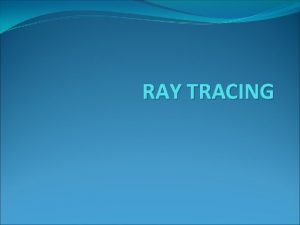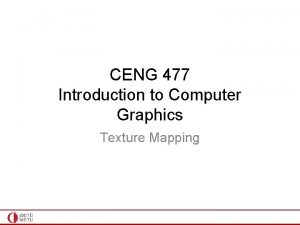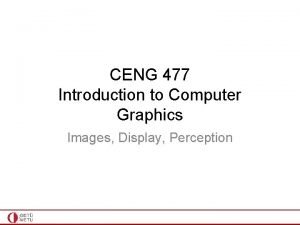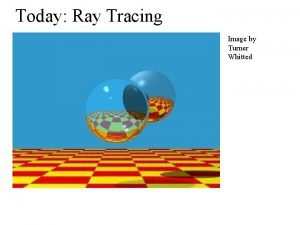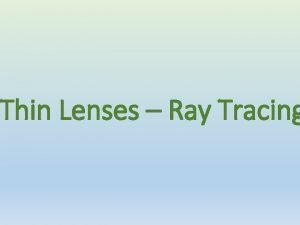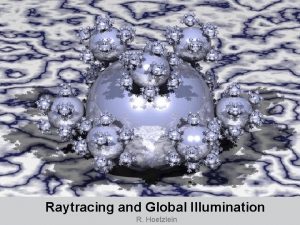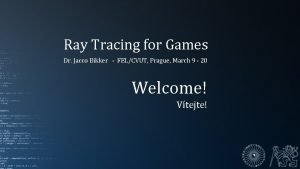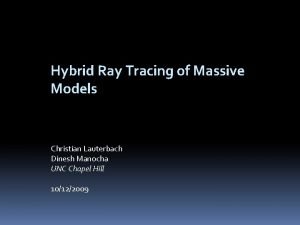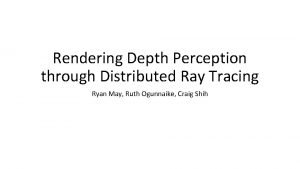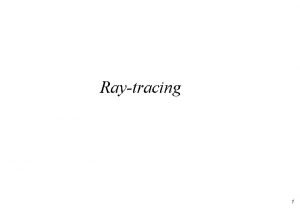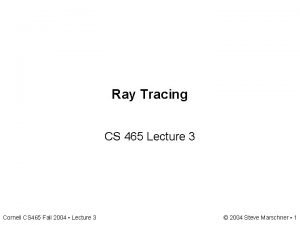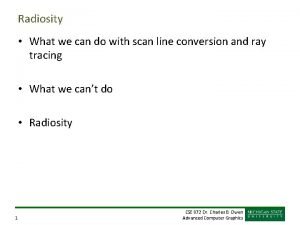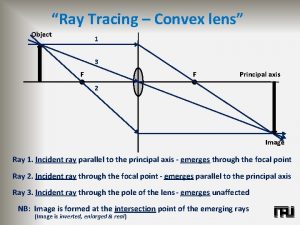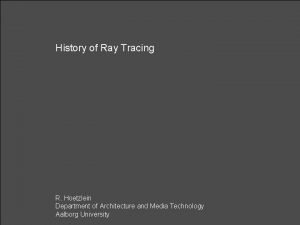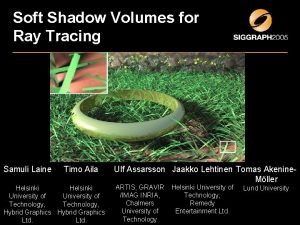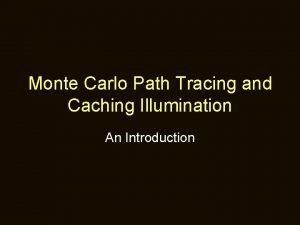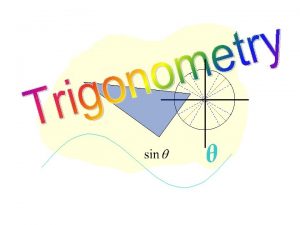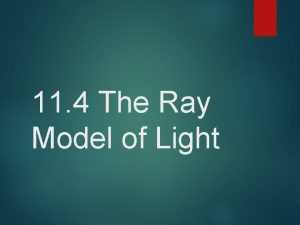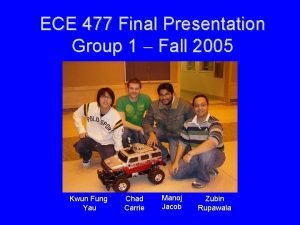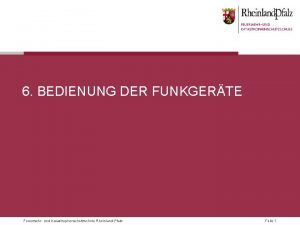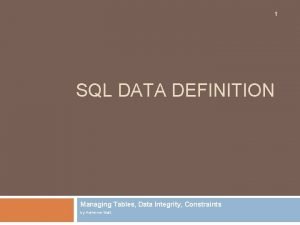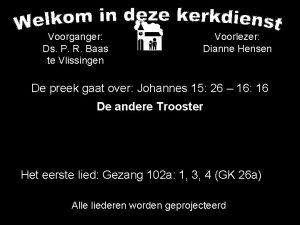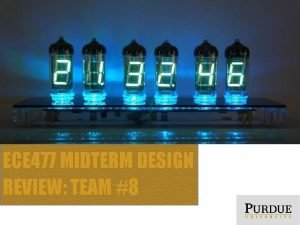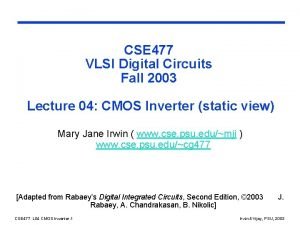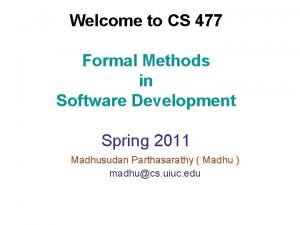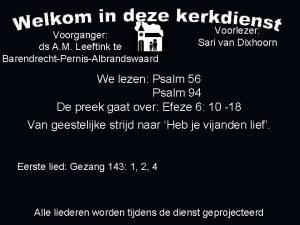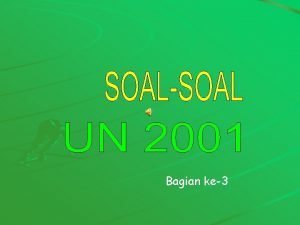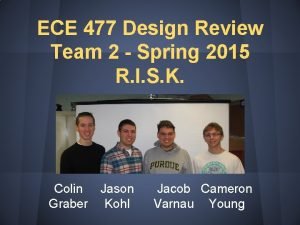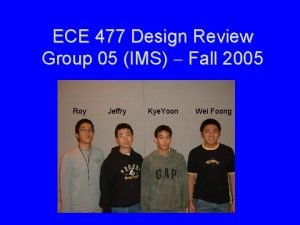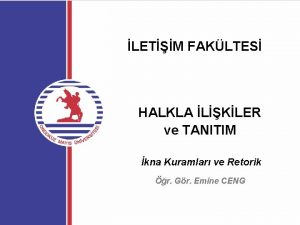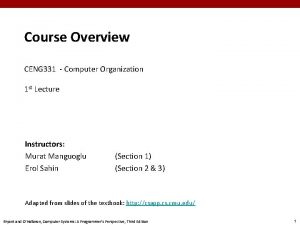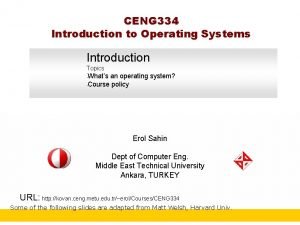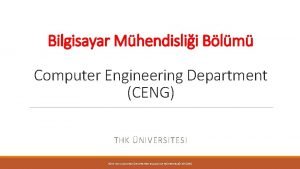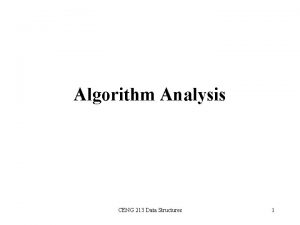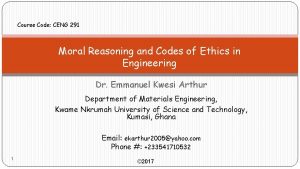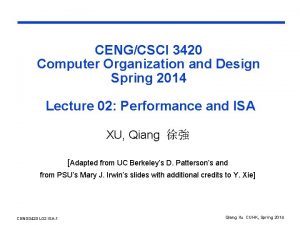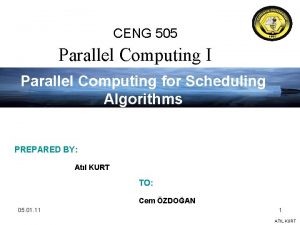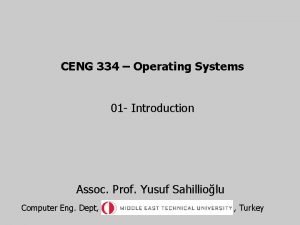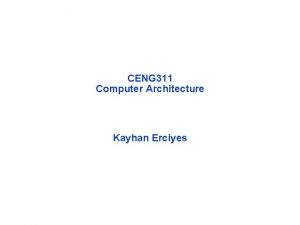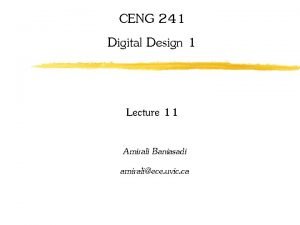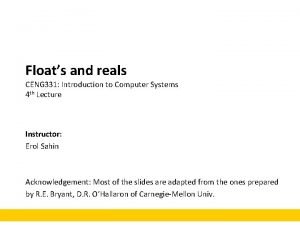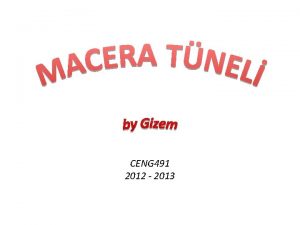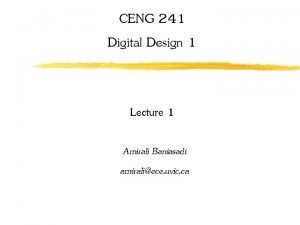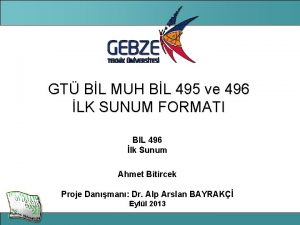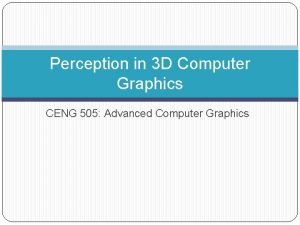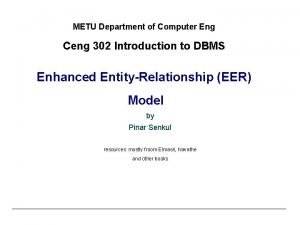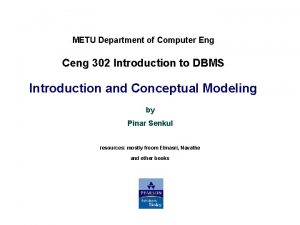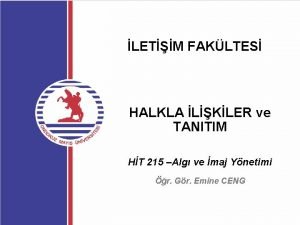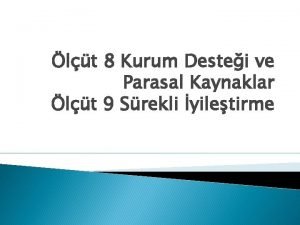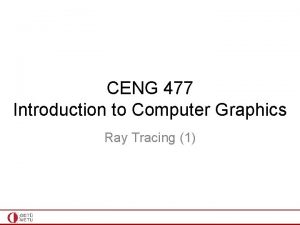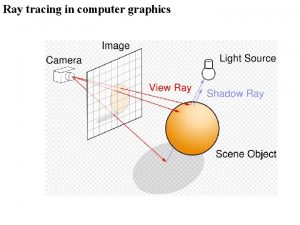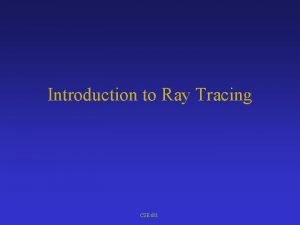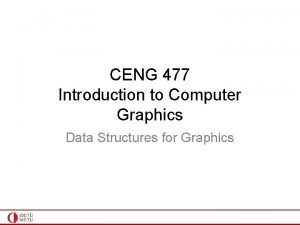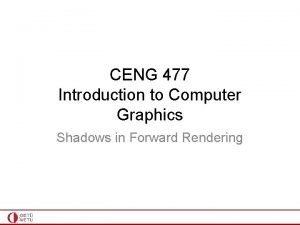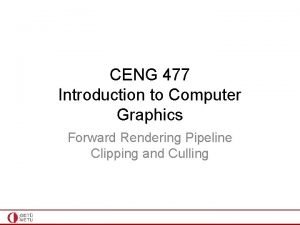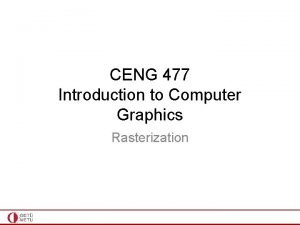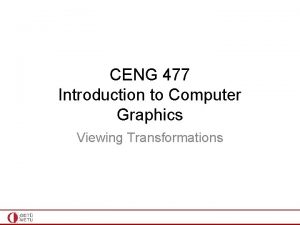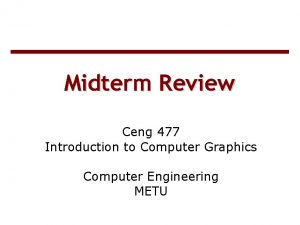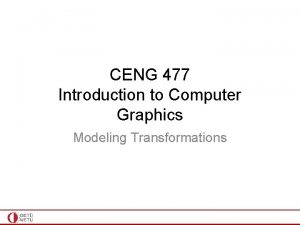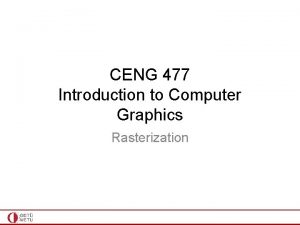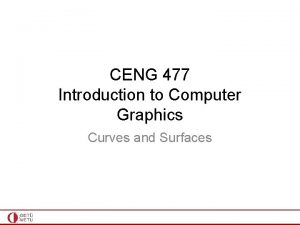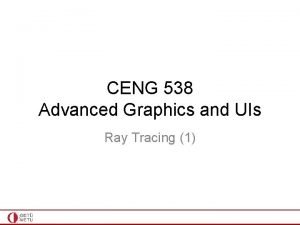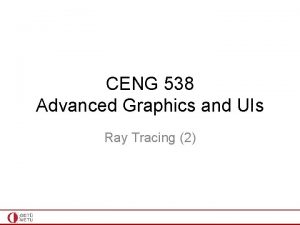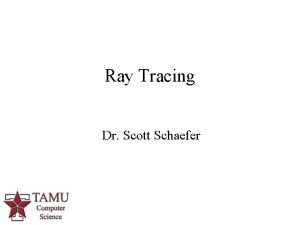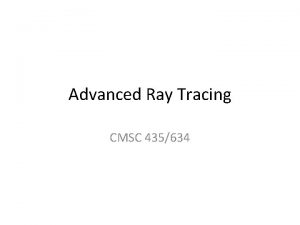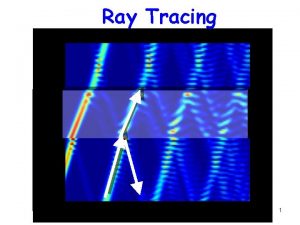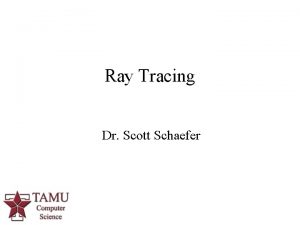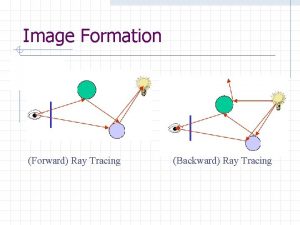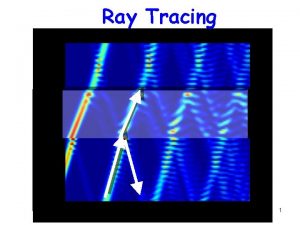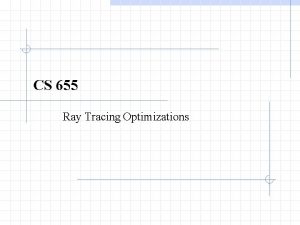CENG 477 Introduction to Computer Graphics Ray Tracing














































































- Slides: 78

CENG 477 Introduction to Computer Graphics Ray Tracing (2)

Last Week • Until now we learned: – How to create the primary rays from the given camera and image plane parameters – How to intersect these rays with various objects: • • • Planes Spheres Triangles Cylinders Boxes CENG 477 – Computer Graphics 2

Algorithm So Far foreach pixel s: compute the viewing ray r (from e to s) tmin = ∞, obj = NULL foreach object o: if r intersects o: if t < tmin: tmin = t, obj = o if obj not NULL: pixel color = color of obj else pixel color = color of background

Image So Far • The image looks bad because we did not use a realistic shading algorithm • We simply set all surface points to the same color • Two spheres with different colors and a gray background • So much work for such a bad image!

With and Without Illumination • Color itself not enough

Reflectance and Power We assumed that each object has a color This is not how it is in reality Each object has a reflectance distribution Each light source has a power distribution Normally, both are functions of wavelength: From forums. gardenweb. com • • •

Reflectance and Power • The object color occurs as a result of their interaction • Same object can appear different under different lights CENG 477 – Computer Graphics 7

foundationsofvision. stanford. edu Reflectance, Power, Cones • Color is perceived due to the interaction of this reflected light by our cone pigments CENG 477 – Computer Graphics 8

Spectral Ray Tracing • Accurately modeling this process requires us to represent all objects and light sources using spectral (i. e. wavelength-based) distributions – Built on physically based equations that model the transportation of light. This allows spectral tracers to accurately capture a wide range of phenomena which most other rendering programs are simply unable to reproduce • Some ray-tracers do this: – Indigo renderer (http: //www. indigorenderer. com/) – Lux renderer (http: //www. luxrender. net/) – Mental ray (http: //www. nvidia-arc. com/products/nvidia-mentalray. html) – … CENG 477 – Computer Graphics 9

RGB Model • We will make a simplifying assumption and represent all objects and light source with three components • Reflectance (obj): – Rr: How much red light it reflects, a value between [0, 1] – Rg: How much green light it reflects, a value between [0, 1] – Rb: How much blue light it reflects, a value between [0, 1] • Power (light): – Ir: How much red light it emits, a value between [0, ∞) – Ig: How much green light it emits, a value between [0, ∞) – Ib: How much blue light it emits, a value between [0, ∞)

Light-Surface Interaction • Light sources are points • Light has a color (mostly white) • Light is pointed to object A – Bounces off A, bounces of walls, . . – Illuminating the room – All these background light assumed to be constant: Ambient Light CENG 477 – Computer Graphics 11

Ambient Shading • Without ambient lights parts of the sphere that do not face the light source are all black – Not realistic • Ambient shading is used as a very crude approximate of the integral in rendering equation; just a constant: Outgoing radiance Ambient reflectance coefficient Ambient light intensity

Ambient Shading Diffuse only Diffuse + Ambient

Light-Surface Interaction • When you put light into a surface, surface scatters the light – Due to the little tiny micro facets on the surface • Scattering controlled by Lambert’s law – If light is barely grazing the surface, very little scattering – If light is looking straight at the surface, lots of scattering • Lambert’s law (cosine law) assumes a perfectly diffusing surface – Surface reflects equally in all directions (looks equally bright from all viewing directions) 14

Light-Surface Interaction • When you put light into a surface, surface scatters the light – Due to the little tiny micro facets on the surface • Scattering controlled by Lambert’s law – If light is barely grazing the surface, very little scattering – If light is looking straight at the surface, lots of scattering • Lambert’s law (cosine law) assumes a perfectly diffusing surface – Surface reflects equally in all directions – Amount of reflection depends on the positioning of light and normal 15

Diffuse Shading • Simulates the phenomenon that a surface can receive radiation only in proportion to its area projected in the direction of the light: wi n Θ’ x wo Outgoing radiance CENG 477 – Computer Graphics Diffuse reflectance coefficient Incoming radiance 16

Diffuse Shading • Note that a diffuse surface reflects equal radiance in all directions (looks equally bright from all viewing directions) • Such a surface is called a Lambertian surface (1760) wi n Θ’ x wo Outgoing radiance CENG 477 – Computer Graphics Diffuse reflectance coefficient Incoming radiance 17

Diffuse Shading • Also, for a point light source, we may apply the inverse square law to attenuate the light based on its distance • This is optional but improves realism Light intensity I wi n r Θ’ x wo Outgoing radiance CENG 477 – Computer Graphics Diffuse reflectance coefficient Light distance 18

Diffuse Shading Example • A sphere shaded by diffuse shading: directxtutorial. com

Illumination So Far • Let Cr, Cg, Cb be the base color of the object – E. g. , (1, 0, 0) if the object is red Θ’ n l (light) • Illumination/Intensity at point x – Ir = Cr*(AMBr + DIFr * n. l) – Ig = Cg*(AMBg + DIFg * n. l) – Ib = Cb*(AMBb + DIFb * n. l) – – Ambient constant (AMBr/g/b) typically 0. 2 Diffuse constant typically 0. 5 Note that n. l is the cos of the angle between n & l as they are unit Summary: decide how much base color is reflected

Add Specular Light r • 1 more thing: Speculation/highlights e (eye) a n l (light) • How light l reflects of something? – – Primarily of direction r If angle a is 0 then eye should get all the lights reflected back to it If you are off the reflection vector, you get lesser reflection e. r gives the desired angle (cos of it) • Cosine falls off to slowly; we want highlights; not diffuse a lot; fade out quickly!! • How about this for quick fall off? (e. r)p (p is called glossiness) dies of quickly

Add Specular Light h • 1 more thing: Speculation/highlights e (eye) n b • How light l reflects of something? – Calculating r is hard – Exponentiation is expensive – Something more practical • h: Halfway between l and e • Consider angle b between n and h • If b=0, then e will be at the perfectly reflecting direction – Insight: If the normal was h it would be reflecting perfectly – b measures how far h is off the real normal • Hence, use specular light term as SPE * (n. h)p – SPE constant: only a portion of light is reflected l (light)

Putting It All Together h • Let Cr, Cg, Cb be the base color of the object n – E. g. , (1, 0, 0) if the object is red l (light) • Illumination at point x – Ir = Cr*(AMBr + DIFr * n. l) + CLr * SPEr * (n. h)p – Ig = Cg*(AMBg + DIFg * n. l) + CLg * SPEg * (n. h)p – Ib = Cb*(AMBb + DIFb * n. l) + CLb * SPEb * (n. h)p – CL is the color of the light source (to be blended w/ base color) • Typically white: (1, 1, 1) – Specular constant typically 0. 3 – Summary: decide how object reflects light specularly (highlights)

Putting It All Together h • Let Cr, Cg, Cb be the base color of the object n – E. g. , (1, 0, 0) if the object is red l (light) • Illumination at point x – Ir = Cr*(AMBr + DIFr * n. l) + CLr * SPEr * (n. h)p – Ig = Cg*(AMBg + DIFg * n. l) + CLg * SPEg * (n. h)p – Ib = Cb*(AMBb + DIFb * n. l) + CLb * SPEb * (n. h)p – For each object how many new parameters you need to specify?

Putting It All Together h • Let Cr, Cg, Cb be the base color of the object n – E. g. , (1, 0, 0) if the object is red l (light) • Illumination at point x – Ir = Cr*(AMBr + DIFr * n. l) + CLr * SPEr * (n. h)p – Ig = Cg*(AMBg + DIFg * n. l) + CLg * SPEg * (n. h)p – Ib = Cb*(AMBb + DIFb * n. l) + CLb * SPEb * (n. h)p – For each object how many new parameters you need to specify? • Cr, Cg, Cb, DIFr, DIFg, DIFb, SPECr, SPEg, SPEb, p //ambient & light. Color fixed

Putting It All Together h • Let Cr, Cg, Cb be the base color of the object n – E. g. , (1, 0, 0) if the object is red • Illumination at point x – Ir = Cr*(AMBr + DIFr * n. l) + CLr * SPEr * (n. h)p – Ig = Cg*(AMBg + DIFg * n. l) + CLg * SPEg * (n. h)p – Ib = Cb*(AMBb + DIFb * n. l) + CLb * SPEb * (n. h)p – Our color model to color our objects includes • Base color Cr/g/b • How much that base color is reflected • How object reflects light specularly (highlights) l (light)

Putting It All Together h • Let Cr, Cg, Cb be the base color of the object n – E. g. , (1, 0, 0) if the object is red • Illumination at point x – Ir = Cr*(AMBr + DIFr * n. l) + CLr * SPEr * (n. h)p – Ig = Cg*(AMBg + DIFg * n. l) + CLg * SPEg * (n. h)p – Ib = Cb*(AMBb + DIFb * n. l) + CLb * SPEb * (n. h)p – Our color model to color our objects includes • Pretty good as long as surfaces look like plastics – Toy Story objects l (light)

Putting It All Together h • Let Cr, Cg, Cb be the base color of the object n – E. g. , (1, 0, 0) if the object is red • Illumination at point x – Ir = Cr*(AMBr + DIFr * n. l) + CLr * SPEr * (n. h)p – Ig = Cg*(AMBg + DIFg * n. l) + CLg * SPEg * (n. h)p – Ib = Cb*(AMBb + DIFb * n. l) + CLb * SPEb * (n. h)p – Play with this model for cool effects • Orange ball orange //bump mapping; play with – In orange normal vectors vary as opposed to the smooth ball surface • Texturing //play with the color you map on the surface Cr/g/b • Vary reflections on objects //play with l • Write your gf’s name with glossy characters //play with p l (light)

Color Model Output Diffuse + Ambient + Specular

Color Model Output • Larger glossiness exponent (p) makes the highlight more focused http: //cgru. sourceforge. net/ CENG 477 – Computer Graphics 30

Terms • The following terms are important when talking about light-surface interaction: – – Power, aka Radiant Power Intensity, aka Radiant Intensity Radiance Irradiance • We already used them but let’s formalize definitions CENG 477 – Computer Graphics 31

Power • Power is the time-rate of energy • It measures how much energy (i. e. in Joules) a light source emits in all possible directions per second • Power is measured in Watts (W = J/s) • Power (P) is also known as flux (Φ) • Rate at which light energy is transmitted Energy time CENG 477 – Computer Graphics 32

Intensity • Intensity is defined as power per solid angle • Typically defined for point light sources and measured in W/sr • Energy distribution of a light source (inverse square law) lec-expert. com Power Solid angle CENG 477 – Computer Graphics 33

Solid Angle • Solid angle is the 3 D generalization of the angle • It corresponds to a surface area on a unit sphere – similar to angle corresponding to a length on a unit circle – measured in steradians CENG 771 – HDRI 34

Radiance • Radiance is defined as power per solid angle per projected area • Radiant intensity per projected area – Light carried by a single ray (no inverse square law) • Measured in Watts per steradian per meter squared (W/sr/m 2) Intensity Projected area CENG 477 – Computer Graphics 35

Radiance • Radiance is the most important unit in ray tracing • Radiance of a ray does not change as the ray travels in empty space (no inverse square law) The Goal of Ray Tracing Compute the radiance along each viewing ray CENG 477 – Computer Graphics 36

Irradiance • Irradiance measures the total incident power per unit area • Measured in W/m 2 Power Area CENG 477 – Computer Graphics 37

Irradiance from Radiance • Irradiance can be computed from radiance: L n Θ dw d. A CENG 477 – Computer Graphics 38

Radiance from Intensity • Finally, radiance can be computed from intensity: I L n Θ dw d. A CENG 477 – Computer Graphics 39

Radiance from Intensity • Now, imagine that d. A was further away • The same intensity would be spread over a larger area • This relationship is governed by the inverse square law I dw L n Θ d. A CENG 477 – Computer Graphics 40

Inverse Square Law • The irradiance emitted by a point light source is reduced by the square of the distance from the source CENG 771 – HDRI 41

Inverse Square Law • Objects further away from the light source appear dimmer as a result • This is why the distance of the stars can be judged by their brightness CENG 771 – HDRI 42

Rendering Equation • Formally these concepts gives us an equation known as the rendering equation – We already discretized it with our color model • It models how much light arriving from an incoming direction (wi) is reflected toward an outgoing direction (wo) CENG 477 – Computer Graphics 43

Rendering Equation Integration over hemisphere Ω Outgoing radiance Emitted radiance Reflectance Function (BRDF) Incoming radiance CENG 477 – Computer Graphics Area Differential correction solid angle factor 44

Rendering Equation • Too costly to evaluate • For each surface point x we need to integrate over the entire hemisphere surrounding x • Simplification: – Exclude all directions except light sources – Add an ambient term to simulate what was excluded – Done with our color model (Slide 26) CENG 477 – Computer Graphics 45

Rendering Equation • Our color model is just an approximation – Maybe the biggest hack in Computer Science • Ideally measure radiant energy for ALL combinations of incident angles – Too much storage – Difficult in practice

Rendering Equation • Our color model is just an approximation – Maybe the biggest hack in Computer Science • Instead using a simple analytical model

Rendering Equation • We approximated the rendering equation as a sum of three simple shading models through our color model: – Diffuse shading – Specular shading – Ambient shading • All models are based on a modified rendering equation: Number of lights Incoming radiance Outgoing radiance Surface reflectance CENG 477 – Computer Graphics 48

Rendering Equation • We can rewrite our color model in terms of Ls • The color of an object at any point can be computed by combining diffuse, ambient, and specular components: • Note that L is vector-valued in which each component represents the radiance for each color channel

Rendering Equation • Diffuse and specular contribution of each light source must be accumulated: Number of light sources L 2 program. com

Surface Normals (Reminder) • A surface normal is a unit vector which is orthogonal to the surface and points outward from the surface n x 1 x n 1 x 2 n 2

Surface Normals (Reminder) • Depends on the type of the object: – For a plane, surface normal is given so you don’t have to do anything (except to normalize it if it isn’t normalized). – For a sphere, compute: n p c R – For a triangle, compute cross product of two edge vectors: c c- a n a b-a b

The Ray Tracing Algorithm – So Far •

Shadows • Shadows can easily be added by checking if the light source is visible from the intersection point – Send ray from object to light (usually: from camera to object) • In the configuration below, point x is in shadow: wi Θ n h α wo x

Shadows • To check if the light source is visible from the intersection point, we can create shadow rays, one for each light source wi Θ n h α wo x

Shadows • Intersect s(t) with all the objects in the scene. If there is no intersection before the light source, the point is not in shadow. Otherwise it is in shadow wi Θ n h α wo x

Shadows • To avoid self intersection due to floating point precision problems, the origin is offset by a very small amount: wi Θ n h α wo x

The Ray Tracing Algorithm – So Far foreach pixel s: compute the viewing ray r (from e to s) tmin = ∞, obj = NULL foreach object o: if r intersects o at point x: if t < tmin: tmin = t, obj = o if obj not NULL: // viewing ray intersected with an object pixel color = La // ambient shading is not affected by shadows foreach light l: compute the shadow ray s from x to l foreach object p: if s intersects p before the light source: continue the light loop; // point is in shadow – no contribution from this light pixel color += Ld + Ls // add diffuse and specular components for this light source else pixel color = color of background (or black)

Image So Far • This looks much better!

Recursive Ray Tracing • Ray tracing is recursive by nature • Color of obj 2 contributes to the color of the current obj 1 (if obj 1 is reflective -- mirror-like for efficiency) CENG 477 – Computer Graphics 60

Recursive Ray Tracing • Ray tracing is recursive by nature • Color of obj 2 contributes to the color of the current obj 1 • To determine color at obj 2, check its shadow ray, and reflection ray, redo for the obj 3, . . CENG 477 – Computer Graphics 61

Recursive Ray Tracing • Ray tracing is recursive by nature • Get. Color calls Ray. Trace recursively – E. g. to be able to reuse the ray generation and intersection code CENG 477 – Computer Graphics 62

Recursive Ray Tracing • True reflection effect is possible via ray tracing • For shiny/mirror-like surfaces (sphere below), spawn a new ray in the reflection direction • Whatever this ray hits (tetrahedron below) is what is reflected in the surface, so can be factored in the ray’s final color • Recall that yellow is shadow ray CENG 477 – Computer Graphics 63

Recursive Ray Tracing • True glass effect is also possible via ray tracing • For glassy surfaces (sphere below), spawn a refraction ray and see where it hits; spawn yet another refraction ray from that exit location • Whatever this ray hits (long box below) is what is reflected in the surface, so can be factored in the ray’s final color • Continue to spawn rays (reflection, refraction) until some limit CENG 477 – Computer Graphics 64

True Reflection (Mirrors) • Back to true reflection effect • Mirror-like objects reflect colors of other objects • Given wo, we must compute wr (reflection direction) wr wr = -wo + 2 ncosΘ = -wo + 2 n(n. wo) n Θ Θ wo n, wo, wr are all unit vectors x Mirror reflection coefficient

True Reflection (Mirrors) • Derivation of reflection vector r • Given incoming light direction d and surface normal n d n (-d. n)n d + (d. n)n r • Hence, r = (-d. n)n + d+(-d. n)n = d + 2(-d. n)n

True Reflection (Mirrors) • For these surfaces the total radiance is equal to local shading radiance plus the radiance from the mirrored location wr n Θ x Θ wo Need to stop after a fixed number of bounces to avoid potentially infinite recursion

Final Image • This looks much better!

Ray Tracing • We have only scratched the surface of ray tracing. • There is so much more that can be done: – – – – – Acceleration structures Modeling non-point light sources (area lights) Refraction (glass-like materials) Participating media (fog, smoke) Subsurface scattering (candles) Parallel and interactive ray tracing Ray tracing on the GPU Photon mapping Image-based lighting … • Ray tracing also useful for picking: When the user clicks the mouse on a pixel in a 3 D graphics program, the program needs to determine which object is visible within that pixel.

Some Ray-traced Images

Some Ray-traced Images Physically Based Ray Tracer

Some Ray-traced Images Physically Based Ray Tracer

Some Ray-traced Images Physically Based Ray Tracer

Some Ray-traced Images Radiance Ray Tracer

Shading Models

Shading Models

Shading Models • 3 colors at triangle vertices known (e. g. via ray tracing) • Coordinates and therefore normal of the triangle known Flat Gouraud All triangle points Linearly interpolate have the same color, vertex colors say v 1. color Phong Linearly interpolate vertex normals, compute color with interpolated normal

Shading Models • 3 colors at triangle vertices known (e. g. via ray tracing) • Coordinates and therefore normal of the triangle known • Phong model will pick up the highlight – Not possible with color averaging (Gouraud) – Not possible with same color everywhere (Flat)
 Ray tracing and ray casting
Ray tracing and ray casting Vray roadmap
Vray roadmap Ceng 477
Ceng 477 Cathode ray tube in computer graphics
Cathode ray tube in computer graphics Most of the graphics monitors today operate as
Most of the graphics monitors today operate as Lcd working principle ppt
Lcd working principle ppt Whitted ray tracing
Whitted ray tracing A lens produces a sharply focused
A lens produces a sharply focused Raytracing vs rasterization
Raytracing vs rasterization Ray tracing actor
Ray tracing actor Christian lauterbach
Christian lauterbach Covexity
Covexity Recursive ray tracing
Recursive ray tracing Albrecht dürer ray tracing
Albrecht dürer ray tracing Ray tracing vs radiosity
Ray tracing vs radiosity Raytrace technologies
Raytrace technologies Ray tracing convex lens
Ray tracing convex lens Matt phar
Matt phar Qualcomm ray tracing
Qualcomm ray tracing Natasha ray
Natasha ray 1/f = 1/do + 1/di
1/f = 1/do + 1/di Ray tracing soft shadows
Ray tracing soft shadows Monte carlo path tracing
Monte carlo path tracing Points and lines in computer graphics ppt
Points and lines in computer graphics ppt Tan 30 degrees unit circle
Tan 30 degrees unit circle Ray model of light
Ray model of light Sw 477
Sw 477 Diketahui log 3 = a dan log 2 = b maka log 18 =
Diketahui log 3 = a dan log 2 = b maka log 18 = Ece 477
Ece 477 Sepura *477
Sepura *477 Biba n 477 ddl
Biba n 477 ddl Experiment 477
Experiment 477 Liedboek 477
Liedboek 477 Ece 477
Ece 477 Cse477
Cse477 Logic solver
Logic solver Opwekking 477
Opwekking 477 Jika log 5 = 0 699 nilai log 20 adalah
Jika log 5 = 0 699 nilai log 20 adalah 3 log 27 artinya
3 log 27 artinya Log 3 = 0 477 dan log 2 = 0 301 nilai log 18 =
Log 3 = 0 477 dan log 2 = 0 301 nilai log 18 = Jika log 3=0 477 dan log 5=0 699 maka log 45 adalah
Jika log 3=0 477 dan log 5=0 699 maka log 45 adalah Ece 477
Ece 477 Ece 477
Ece 477 Emine ceng
Emine ceng Ceng 考牌
Ceng 考牌 Ceng334
Ceng334 Imech
Imech Ceng 334
Ceng 334 Cow.ceng.metu.edu tr
Cow.ceng.metu.edu tr Ceng thkü
Ceng thkü Citp vs ceng
Citp vs ceng Ceng 213
Ceng 213 What is the difference between ethics and law
What is the difference between ethics and law Ceng 3420
Ceng 3420 Ceng 505
Ceng 505 Ceng351
Ceng351 Ceng334
Ceng334 Iyte ceng
Iyte ceng Ceng 241
Ceng 241 Double float
Double float Ceng 491
Ceng 491 Ceng 241
Ceng 241 Nem ceng
Nem ceng Ceng 112
Ceng 112 Gtü ceng
Gtü ceng 41/72 simplified
41/72 simplified Ceng302
Ceng302 Metu databases
Metu databases Kalıp yargı örnekleri
Kalıp yargı örnekleri Ceng302
Ceng302 Mskü ceng
Mskü ceng Eur ing vs ceng
Eur ing vs ceng Odtü bilgisayar mühendisliği mezunları
Odtü bilgisayar mühendisliği mezunları Angel computer graphics
Angel computer graphics Projection types in computer graphics
Projection types in computer graphics Plasma panel display in computer graphics
Plasma panel display in computer graphics Two dimensional viewing
Two dimensional viewing Shear transformation in computer graphics
Shear transformation in computer graphics Glsl sincos
Glsl sincos
